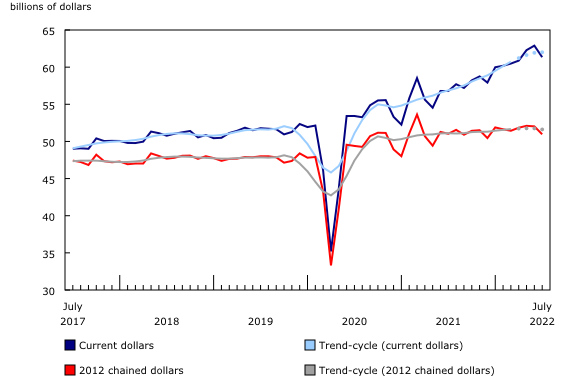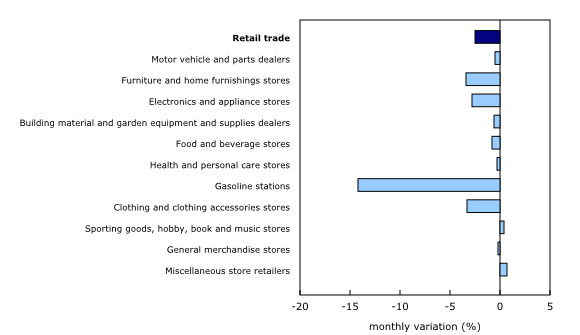Retail trade, July 2022
Released: 2022-09-23
$61.3 billion
July 2022
-2.5% 
(monthly change)
$919.1 million
July 2022
2.5% 
(monthly change)
$277.5 million
July 2022
-0.1% 
(monthly change)
$1,673.0 million
July 2022
0.7% 
(monthly change)
$1,381.0 million
July 2022
-0.1% 
(monthly change)
$13,656.1 million
July 2022
-1.5% 
(monthly change)
$22,529.5 million
July 2022
-5.0% 
(monthly change)
$2,132.5 million
July 2022
-1.9% 
(monthly change)
$2,003.2 million
July 2022
-3.7% 
(monthly change)
$8,052.9 million
July 2022
0.8% 
(monthly change)
$8,511.9 million
July 2022
-1.5% 
(monthly change)
$86.4 million
July 2022
-6.6% 
(monthly change)
$71.8 million
July 2022
-5.3% 
(monthly change)
$45.5 million
July 2022
-1.2% 
(monthly change)
Retail sales decreased 2.5% to $61.3 billion in July, the first decline observed in seven months. Sales were down in 9 of 11 subsectors, representing 94.5% of retail trade. The decrease was driven by lower sales at gasoline stations and clothing and clothing accessories stores.
Core retail sales—which exclude gasoline stations and motor vehicle and parts dealers—decreased 0.9%.
In volume terms, retail sales were down 2.0% in July.
Given the continually evolving economic situation, Statistics Canada is providing an advance estimate of retail sales, which suggests that sales increased 0.4% in August. Owing to its early nature, this figure will be revised. This unofficial estimate was calculated based on responses received from 51.1% of companies surveyed. The average final response rate for the survey over the previous 12 months has been 91.0%.
Lower sales at gasoline stations and motor vehicle and parts dealers
Leading the decrease in retail sales in July were lower sales at gasoline stations (-14.2%), which recorded their first decline in seven months. In volume terms, sales at gasoline stations decreased 7.0%. Gasoline prices fell 9.2% on an unadjusted basis in July. Ongoing concerns related to a slowing global economy continued to put downward pressure on gas prices.
Sales at motor vehicle and parts dealers fell 0.5% in July. The decline was largely the result of lower sales at new car dealers (-0.6%). Lower sales were also reported at used car dealers (-1.7%) and automotive parts, accessories and tire stores (-0.9%). In contrast, other motor vehicle dealers (+2.4%) were the only store type in this subsector to increase.
Core retail sales decline
Core retail sales decreased 0.9% in July—the first decrease in seven months. Leading the decrease were sales at clothing and clothing accessories stores (-3.3%). The decrease was observed across all three store types in the subsector, with clothing stores (-3.3%) experiencing the largest decline.
Lower sales were also observed at food and beverage stores (-0.8%), which were led by a decline in supermarkets and other grocery (except convenience) stores (-0.9%) and beer, wine and liquor stores (-1.2%).
The largest increase to core retail came from miscellaneous store retailers, which increased 0.7%. Stores in this subsector include pet stores, cannabis stores and office supplies and stationery stores.
Sales down in seven provinces
Retail sales decreased in seven provinces in July, led by lower sales in Ontario (-5.0%). Leading the decline in Ontario were lower sales at gasoline stations. Gasoline prices fell the most in Ontario, where the provincial government temporarily lowered the gasoline tax. In the census metropolitan area (CMA) of Toronto, retail sales fell 5.7%.
Lower retail sales were observed in Quebec (-1.5%). In the CMA of Montréal, sales fell 2.3%.
Retail sales were also lower in British Columbia (-1.5%), led by lower sales at gasoline stations. Retail sales were down 2.2% in the CMA of Vancouver.
Retail e-commerce sales in Canada
On a seasonally adjusted basis, retail e-commerce sales were down 0.7% in July.
On an unadjusted basis, retail e-commerce sales were up 4.3% year over year to $3.2 billion in July, accounting for 4.7% of total retail trade. The share of e-commerce sales out of total retail sales fell 0.1 percentage points compared with July 2021.
Note to readers
All data in this release are seasonally adjusted and expressed in current dollars, unless otherwise noted.
Seasonally adjusted data are data that have been modified to eliminate the effect of seasonal and calendar influences to allow for more meaningful comparisons of economic conditions from period to period. For more information on seasonal adjustment, see Seasonally adjusted data – Frequently asked questions.
The percentage change for the advance estimate of retail sales is calculated using seasonally adjusted data and is expressed in current dollars.
This early indicator is a special product being provided in the context of the COVID-19 pandemic to offer Canadians timely information on the retail sector. The data sources and methodology used are the same as those outlined on the Monthly Retail Trade Survey information page.
Trend-cycle estimates are included in selected charts as a complement to the seasonally adjusted series. These data represent a smoothed version of the seasonally adjusted time series and provide information on longer-term movements, including changes in direction underlying the series. For information on trend-cycle data, see Trend-cycle estimates – Frequently asked questions.
Both seasonally adjusted data and trend-cycle estimates are subject to revision as additional observations become available. These revisions could be extensive and could even lead to a reversal of movement, especially for the reference months near the end of the series or during periods of economic disruption.
Seasonally adjusted estimates for cannabis store retailers are presented in unadjusted form since no seasonal pattern has been established by official statistics yet. Establishing such a pattern requires several months of observed data. In the interim, the seasonally adjusted estimates for cannabis store retailers will be identical to the unadjusted figures.
Statistics Canada's retail e-commerce figures include the electronic sales of two distinct types of retailers. The first type does not have a storefront. These businesses are commonly referred to as pure-play Internet retailers and are classified under the North American Industry Classification System (NAICS) code 45411—electronic shopping and mail-order houses. The second type has a storefront and is commonly referred to as a brick-and-mortar retailer. If the online operations of a brick-and-mortar retailer are separately managed, they, too, are classified under NAICS code 45411.
Some common e-commerce transactions, such as travel and accommodation bookings, ticket purchases, and financial transactions, are not included in Canadian retail sales figures.
For more information on retail e-commerce in Canada, see "Retail E-Commerce in Canada."
Total retail sales expressed in volume terms are calculated by deflating current-dollar values using consumer price indexes.
Find more statistics on retail trade.
Real-time tables
Real-time tables 20-10-0054-01 and 20-10-0079-01 will be updated soon.
Next release
Data on retail trade for August will be released on October 21, 2022.
Contact information
For more information, or to enquire about the concepts, methods or data quality of this release, contact us (toll-free 1-800-263-1136; 514-283-8300; infostats@statcan.gc.ca) or Media Relations (statcan.mediahotline-ligneinfomedias.statcan@statcan.gc.ca).
- Date modified:


